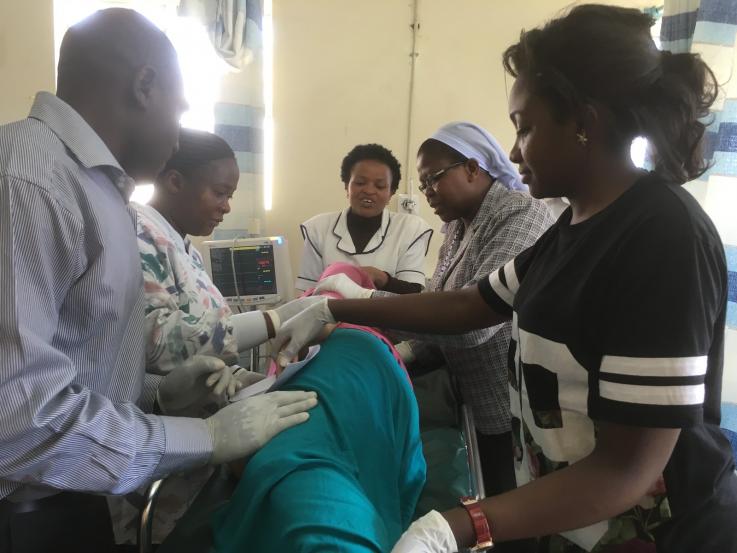
What if one of the leading contributors to disability and death worldwide wasn’t a disease, infection, or virus? What if it was a systematic failure to prioritize the question “how do you get what works to the people who need it?”
Take the current COVID-19 pandemic. In April 2021, all adults in the U.S. became eligible for vaccination. A year later, only 75% of the adult population is fully vaccinated. Globally, the numbers are significantly lower. Across Africa, only 15% of the adult population is fully vaccinated, according to the World Health Organization.
This gap between knowing an intervention works and successfully delivering it (often called the know-do gap) represents one of the biggest challenges to equitable delivery and access to evidence-based healthcare.
“What we consistently see is that we have interventions that work – be that a pill or a vaccine or a mask – and yet we still see morbidity and mortality due to infections and diseases that either we can prevent or treat,” says Anjuli Wagner, an assistant professor of global health at the University of Washington.
Enter implementation science, the study of methods to increase the uptake of evidence-based health interventions. The UW Implementation Science Program (ISP) is a recognized leader in the development of knowledge and tools to inform and enhance implementation practices.
For example, when the National Academics of Sciences, Engineering, and Medicine convened a committee to analyze how the response to COVID-19 could inform future responses to influenza, they invited Wagner, along with fellow UW assistant professor of global health Arianna Means, to present on how implementation science might be used to prevent the next influenza pandemic. Their recommendations are included in Public Health Lessons for Non-Vaccine Influenza Interventions: Looking Past COVID-19.
According to Bryan Weiner, a professor of global health and director of the ISP, part of what sets UW apart from other institutions is its expertise in both domestic and global health implementation science.
“I can easily think of half a dozen universities where there's a critical mass of people doing cutting-edge, important domestic implementation science. To my knowledge, this is the only university where there’s a critical mass of people doing cutting-edge, important implementation science both domestically and globally,” says Weiner.
Domestic implementation science tends to focus on individual behavior change, whereas global implementation science tends to focus on health systems change. The dual emphasis at UW allows researchers to draw on best practices from both specialties to produce knowledge that not only helps solve problems in a particular setting but is generalizable to other people, places, and times.
This combination of practicality and flexibility is what UW global health professor Kenneth Sherr had in mind when he created the Systems Analysis and Improvement Approach (SAIA), a unique implementation strategy that packages system engineering tools into a user-friendly five-step process that can be applied across a wide range of diseases, environments, and contexts.
“These tools are all about simplifying complexity and guiding decision making in an interactive, ongoing way to improve how health services operate,” says Sherr, who is also co-director of the PhD in Health Metrics and Implementation Science program at UW, the first of its kind in the country.
SAIA was initially developed to help identify and address inefficiencies in the long-term care of pregnant and post-partum women living with HIV, with the ultimate goal of eliminating mother-to-child transmission (MTCT). The original trial – evaluated through a 9-month cluster randomized-controlled trial in Côte d’Ivoire, Kenya and Mozambique – demonstrated substantial improvements in maternal anti-retroviral initiation and early infant testing. Due to its success, researchers are now assessing how to scale SAIA to address MTCT across large, public sector health systems.
Reducing MTCT in sub-Saharan Africa is just one of many applications of SAIA. UW researchers are testing its effectiveness at lowering rates of cervical cancer in Kenya, decreasing the number of young people involved in the criminal legal system in Washington, and improving community-based distribution of naloxone in Northern California.
“We’re trying to build an evidence base about how SAIA can improve service delivery for important conditions both globally and in the US. We’d love to see this named as a best practice for organization-level improvement,” said Sherr.
In the meantime, UW researchers are also working to advance the field of implementation science by embedding implementation questions into clinical trials to facilitate the translation of evidence into practice. One such hybrid project, the DeWorm3 Study, is testing the feasibility of interrupting the transmission of soil transmitted helminths (STH), while simultaneously conducting implementation science research to contextualize findings and provide guidance on opportunities to optimize delivery of interventions.
“What makes our work special is that we're thinking about strategies for improving implementation but we're also keeping an eye on clinical outcomes,” says Means, a co-lead of the DeWorm3 Study. “At the end of the day, we're trying to improve human health and human well-being via improved implementation.”
To have the biggest impact possible, Weiner says he hopes the research and strategies generated by the IS program will become common scientific knowledge, available to other academic fields of study, implementation scientists, and public health leaders.
“The goal is not to just produce more articles, the goal is to produce usable, useful knowledge in the form of tools, techniques, methods, and approaches that will help practitioners to improve their practice of implementation,” says Weiner.
By Amy Frances Goldstein